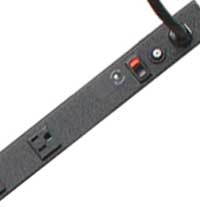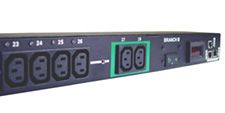Recently, we brought you the first
part of a six-part series chronicling the ways in which
Chatsworth Products, Inc. (CPI) is addressing the top concerns of
data center managers today. As documented by the IT blog Data Center
Knowledge in their
2011 Data Center Market Insight Report, these concerns reveal
how skyrocketing demand in data storage and maintenance is
stretching the limits of capacity, power, design and more. Today,
we explore the fifth-most pressing issue: Running Out of
Power.
 True story: I once worked in an office setting of
about 10 people, all sharing the same common area with different
workstations. We had the usual set-up - electrical outlet below the
desk, surge protector powering a computer, monitor, the occasional
lamp and/or digital picture frame, and on one particularly cold
December morning, a portable space heater (what can I say, the
building was an ice-box!).
True story: I once worked in an office setting of
about 10 people, all sharing the same common area with different
workstations. We had the usual set-up - electrical outlet below the
desk, surge protector powering a computer, monitor, the occasional
lamp and/or digital picture frame, and on one particularly cold
December morning, a portable space heater (what can I say, the
building was an ice-box!).
Long story short, I bypassed the surge protector, plugged in,
flipped the switch, then heard a collective GROAN and GASP as the
juice literally ran dry. Power, OUT. For those in the middle of
typing an email or meticulously editing the next ad, I could only
hope the auto-save feature would save me from the wrath of my
disgruntled, and yup, powerless, co-workers. The space heater (see:
straw that broke the camel's back) sapped the power, caused us all
to crash, and taught me an important lesson in economizing one's
electricity use.
For data center managers dealing with economizing electricity
use and power management, the stakes are unequivocally higher and
the electrical infrastructure, far more complex. Already considered
one of the world's biggest energy hogs, data centers are now
predicted to use 19 percent more energy in the next 12 months (over
the previous year), according to results of a global industry
census conducted by DatacenterDynamics.
And while the rate at which we consume electricity in the data
center continues to grow, so too have the number of options
available to better manage and moderate this power. Those in fear
of running out of power need only run their concerns by CPI for
total support.
 That's because we offer power management
at every level. For basic applications with relatively low power
requirements, CPI's rack-mount Power Strips
come in basic or metered models, NEMA and IEC style outlets and
plugs, and can be configured as multiple strips offering much
needed power redundancy.
That's because we offer power management
at every level. For basic applications with relatively low power
requirements, CPI's rack-mount Power Strips
come in basic or metered models, NEMA and IEC style outlets and
plugs, and can be configured as multiple strips offering much
needed power redundancy.

In large-scale data centers, our rack-mount Power
Distribution Units (PDUs) allow users to remotely monitor power
use (down to the individual device/server level), temperature and
humidity using CPI's
Scalable Enterprise Management Application (SEMA) Software.
For these intelligent PDU offerings, CPI also
offers the optional features of an in-line ammeter that displays
the amount of current being used and switchable outlets for remote
power cycling, as well as the ability to monitor each individual
outlet (port monitoring).
Furthermore, the availability of Three-Phase
Power in many of CPI's Power Strips and PDUs offers almost
two times the power over single-phase at a lower cabling cost,
better load balancing, more efficient, higher density and scalable
for future growth.
When it comes to remotely managing all this power, CPI's
SEMA Software offers data center operators:
 - KVM switching and asset management
- KVM switching and asset management
- Intuitive web-based interface with map, room and
rack-level views of data center
- Storage of critical info about each device in
searchable, centralized database
- Current-usage reporting, power cycling and threshold
alarms when paired with controlled CPI PDUs
The precision in power management doesn't end there. For those
wishing to first analyze their power
usage effectiveness (PUE) before deciding upon new equipment,
CPI even offers a powerful PUE
Calculator to help lower your power into the data center over
power used to run the infrastructure ratio (for an even deeper
explanation of PUE, click here).
While my own "running out of power" moment caused some temporary
headaches around the office, there's no denying that poor power
management at the data center level can affect A LOT more than 10
people. Before you hear the collective groans and gasps of your
customers and clients, do the right thing: power up. Jeff Cihocki, eContent Specialist